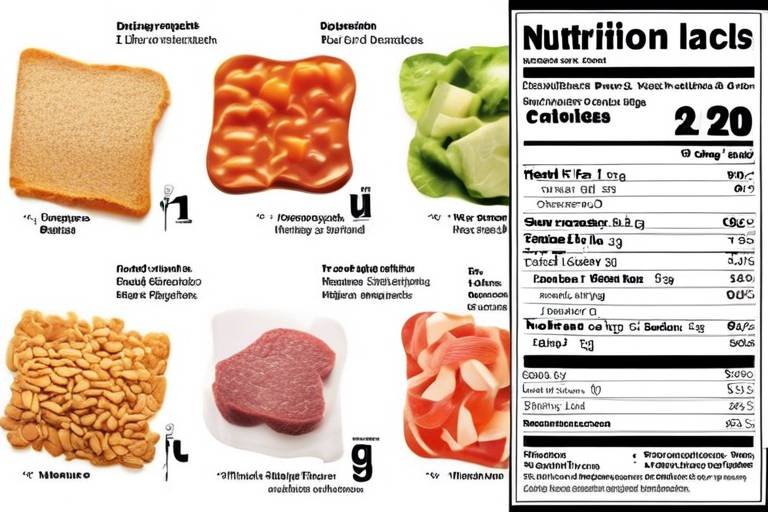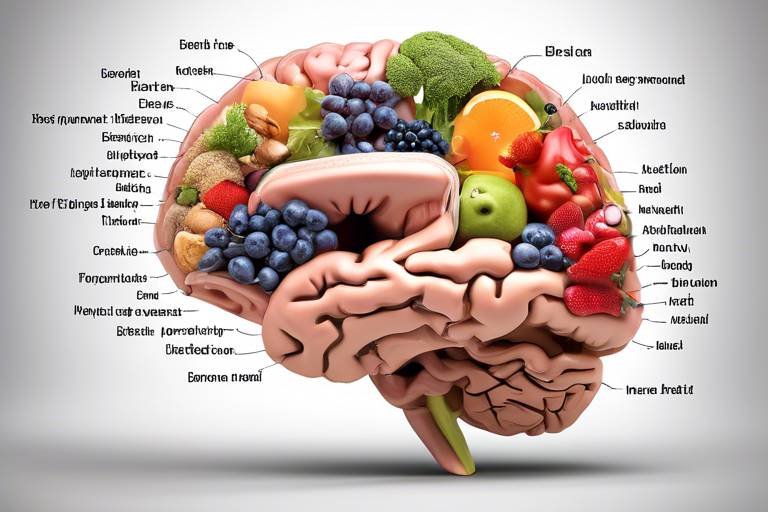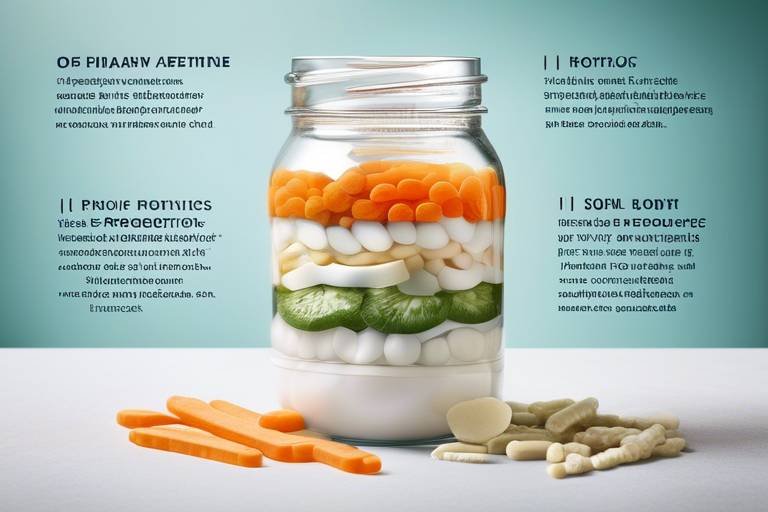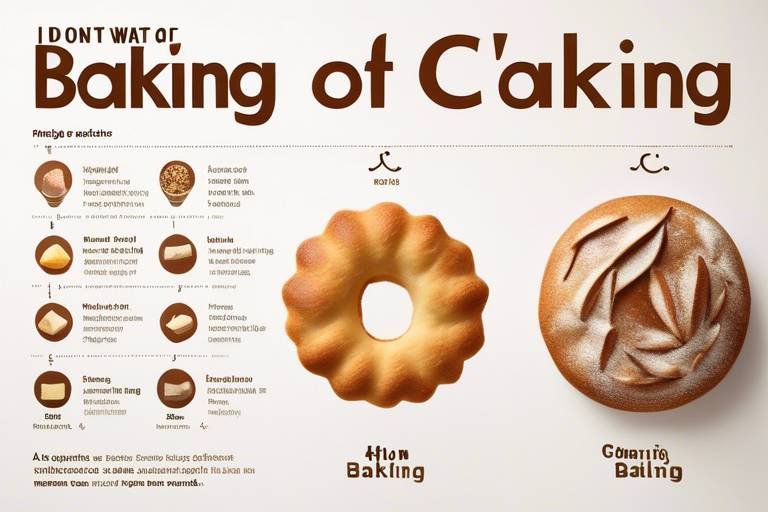How Nutrition Labels Impact Our Choices - The Science
Have you ever stood in the grocery aisle, staring at a box of cereal, trying to decipher whether it’s a healthy choice or just another sugary trap? You’re not alone! Nutrition labels are designed to help us make informed decisions about our food, but their impact goes beyond just numbers and ingredients. Understanding how these labels influence our choices can be a game changer in our quest for better health.
Nutrition labels serve as a roadmap for consumers, guiding us through the often confusing world of food products. They provide crucial information about what we’re putting into our bodies, from calorie counts to nutrient breakdowns. But why do they matter? Well, when we understand what these labels mean, we can make healthier dietary choices that promote overall well-being. Imagine walking into a store equipped with the knowledge to choose foods that align with your health goals—sounds empowering, right?
But let’s dive deeper into the science behind these labels. It’s fascinating to see how the components of a nutrition label can influence our decisions. For instance, the serving size is a critical element. It’s not just a number; it’s a guideline that can significantly affect how we perceive portion control. When we recognize the recommended serving size, we gain a better understanding of our calorie and nutrient intake, which can lead to healthier eating habits.
However, there’s a catch! Many consumers struggle with portion distortion, where they misjudge serving sizes, leading to increased calorie consumption. This phenomenon can be likened to driving a car without a speedometer; you might think you’re going at a safe speed, but without the right information, you could be speeding without even knowing it. Awareness of portion distortion can help individuals make better choices and manage their weight effectively.
Another essential aspect of nutrition labels is the nutritional information itself. This includes details about fats, sugars, and proteins, which offer insights into the healthfulness of food products. For those aiming to meet specific dietary goals, this information is invaluable. It’s like having a personal nutrition coach right on the packaging, ready to guide you through your choices.
Now, let’s talk about the psychology of label reading. The way we interpret nutrition labels is influenced by various psychological factors. For example, did you know that color coding and appealing design elements can significantly impact consumer behavior? Research shows that visually engaging labels often lead to healthier choices. Think about it: a bright, colorful label can draw your attention and make you feel more positive about the product, potentially swaying your decision.
However, it’s not just about looks. The cognitive load associated with reading and interpreting nutrition labels can also affect our decision-making. If a label is too complicated or cluttered, it can overwhelm us and lead to poor choices. Simplifying labels may enhance understanding and encourage healthier eating habits. It’s like trying to solve a puzzle with too many pieces—sometimes, less is more!
Moreover, government regulations and standards play a vital role in nutrition labeling. These regulations ensure consistency and reliability, helping consumers trust the information provided on food packaging. When you see a nutrition label, you can feel more confident that the information is accurate and standardized, allowing you to make choices based on facts rather than guesswork.
As we look to the future, it’s clear that nutrition labeling is evolving. With growing consumer awareness, we can expect innovations that include clearer formats and additional information to better support informed dietary choices. Imagine a world where nutrition labels not only tell you what’s in your food but also provide personalized recommendations based on your health goals. Exciting, isn’t it?
- What is the purpose of nutrition labels?
Nutrition labels provide essential information about the contents of food products, helping consumers make informed dietary choices. - How can I better understand serving sizes?
Pay attention to the serving size listed on the label and compare it to the portion you typically consume to avoid portion distortion. - Are nutrition labels regulated?
Yes, government regulations ensure that nutrition labels are consistent and reliable, providing consumers with trustworthy information. - What trends can we expect in nutrition labeling?
Future trends may include clearer formats and additional information to support informed dietary choices as consumer awareness grows.

The Importance of Nutrition Labels
Nutrition labels serve as vital tools for consumers, offering essential information about food products. They act as a compass in the vast sea of food choices we face every day. With the rise of processed foods and complex diets, understanding these labels can empower individuals to make healthier dietary decisions. Imagine walking through a grocery store, surrounded by colorful packages and enticing advertisements. It can be overwhelming, right? That's where nutrition labels come to the rescue, providing clarity amidst the chaos.
One of the primary benefits of nutrition labels is that they help consumers make informed choices. When you glance at a label, you’re not just looking at numbers; you’re decoding a story about what you’re putting into your body. This information can guide you in selecting products that align with your health goals, whether you're aiming to lose weight, build muscle, or simply maintain a balanced diet. By understanding the nutritional content, you can avoid hidden sugars and unhealthy fats that may lurk in seemingly innocent snacks.
Moreover, nutrition labels can significantly influence public health. By promoting awareness of food contents, they encourage better eating habits across communities. For instance, studies have shown that when consumers are educated about the nutritional value of their food, they're more likely to choose options that are lower in calories and higher in essential nutrients. This shift not only benefits individual health but can also lead to a decrease in diet-related diseases, such as obesity and diabetes.
To illustrate this point, consider the following table that summarizes the impact of nutrition label awareness on consumer choices:
| Consumer Awareness Level | Healthier Choices (% Increase) | Reduction in Unhealthy Purchases (% Decrease) |
|---|---|---|
| Low Awareness | 15% | 10% |
| Moderate Awareness | 30% | 20% |
| High Awareness | 50% | 35% |
This table emphasizes the undeniable link between nutrition label awareness and healthier consumer behavior. As you can see, the more informed consumers are about what they eat, the better choices they tend to make. This knowledge is crucial in today’s fast-paced world where convenience often trumps health.
In conclusion, nutrition labels are not just bureaucratic jargon on the back of a package; they are essential tools that guide us toward healthier eating habits. They help us navigate through the myriad of food options available, ensuring that we can make choices that support our health and well-being. So, the next time you reach for a snack, take a moment to check the label—it could be the difference between a healthy choice and a regretful one.

Understanding Label Components
Navigating the world of nutrition labels can feel like deciphering a secret code, but understanding the key components is crucial for making informed food choices. Nutrition labels are designed to give consumers a snapshot of what they're eating, and knowing how to read them can empower you to make healthier decisions. At first glance, these labels may seem overwhelming, but breaking down their components reveals a wealth of information that can help us manage our diets effectively.
One of the most important elements of a nutrition label is the serving size. This is not just a random number; it’s a guideline that tells you how much of the product is considered one serving. For example, if a cereal box states that a serving size is one cup, but you pour yourself two cups, you’re doubling your intake of calories and nutrients without even realizing it. Recognizing the recommended serving size is vital for understanding both your calorie and nutrient intake. It’s like having a roadmap for your meals—without it, you might find yourself lost in a sea of choices.
Understanding serving sizes is crucial for maintaining a balanced diet. When you know how much constitutes a serving, you can better gauge your caloric intake. This is where the concept of caloric intake comes into play. If you’re trying to manage your weight, knowing the serving size can help you avoid the pitfall of overeating. For instance, if you regularly consume two servings of a snack, you might be consuming more calories than you intended. Recognizing this can lead to healthier choices, allowing you to enjoy your favorite foods without the guilt.
Moreover, understanding serving sizes directly impacts your caloric intake. Research has shown that individuals who accurately gauge serving sizes are more likely to maintain a balanced diet. It’s all about making informed choices. Think of it this way: if you were driving a car, would you want to know how much fuel you have left? The same principle applies to food—knowing what you’re consuming can help you fuel your body appropriately.
On the flip side, we have the issue of portion distortion. This phenomenon occurs when consumers misjudge serving sizes, often leading to increased calorie consumption. Many of us are guilty of this—when faced with a big bag of chips, it’s easy to lose track of how much we’ve eaten. Being aware of portion distortion can help you make better choices and manage your weight effectively. It’s like standing in front of a mirror and realizing that your perception might not match reality. Awareness is the first step toward making healthier decisions.
Another critical component of nutrition labels is the nutritional information, which includes details about fats, sugars, proteins, and other essential nutrients. This information is invaluable for individuals aiming to meet specific dietary goals, whether it's reducing sugar intake or ensuring adequate protein consumption. For instance, if you’re trying to cut back on sugar, a quick glance at the label can help you steer clear of products that are high in added sugars. It’s like having a personal nutritionist right there on the packaging, guiding you toward better choices.
| Nutrient | Recommended Daily Value |
|---|---|
| Fats | 70g |
| Sugars | 30g |
| Proteins | 50g |
By familiarizing yourself with these components, you can take control of your dietary choices. Nutrition labels are not just a set of numbers; they are your allies in the quest for better health. So, the next time you pick up a food product, take a moment to read the label. It might just change the way you think about your meals.
- What is the significance of serving size on nutrition labels? Serving size helps consumers understand how much they should eat and how many calories they are consuming.
- How can I accurately judge serving sizes? Use measuring cups or scales at home to familiarize yourself with actual serving sizes.
- What should I look for in nutritional information? Focus on key nutrients like sugars, fats, and proteins, and compare them to your dietary goals.

Serving Size
When it comes to nutrition labels, is a crucial element that can significantly influence our eating habits. Think of it as the starting point for understanding how much of a particular food we should consume. It’s like the foundation of a house; without it, everything else can become unstable. The serving size indicates the amount of food that is typically consumed in one sitting and is used to calculate the nutritional information provided on the label.
Understanding serving sizes can be a game changer for those looking to manage their weight or improve their overall health. For instance, have you ever noticed that a bag of chips lists a serving size of just 10 chips? At first glance, it might seem trivial, but if you’re munching away while watching your favorite show, it’s easy to lose track of how many you’ve actually eaten. This is where the concept of portion control comes into play.
Many people struggle with portion distortion, which is when the perceived serving size differs from the actual recommended size. This can lead to unintentional overeating. For example, if you pour out a bowl of cereal without measuring, you might end up consuming two or three servings instead of one. To combat this, it’s essential to familiarize yourself with common serving sizes for various foods. Here’s a quick reference table to help you:
| Food Item | Typical Serving Size |
|---|---|
| Cereal | 1 cup |
| Cooked Pasta | 1 cup |
| Meat (Chicken, Beef) | 3 ounces |
| Cheese | 1.5 ounces |
| Vegetables | 1 cup raw or ½ cup cooked |
By paying attention to serving sizes, you can make better choices and manage your caloric intake more effectively. It’s not just about counting calories; it’s about understanding what those numbers mean in terms of your overall diet. When you know how much you’re consuming, you’re less likely to overindulge and more likely to stick to your health goals.
In today’s fast-paced world, where convenience often trumps nutrition, taking the time to read and comprehend serving sizes on nutrition labels can make a significant difference. It empowers you to make informed choices that align with your health objectives. So next time you grab a snack or prepare a meal, take a moment to check the serving size—it might just be the key to a healthier you!

Impact on Caloric Intake
The relationship between serving sizes and caloric intake is a critical aspect of nutrition labels that often goes unnoticed. When consumers grasp the recommended serving size, they gain a clearer understanding of how many calories they are actually consuming. This awareness can be a game-changer for anyone looking to maintain a balanced diet or manage their weight. Imagine standing in front of a delicious-looking bag of chips. If the label indicates that a serving is just 10 chips but you’re munching away at 30, you’re unknowingly tripling your caloric intake. This kind of discrepancy can easily lead to weight gain over time, as those extra calories add up.
Research has shown that individuals who accurately gauge their serving sizes tend to make healthier choices. They become adept at recognizing how many calories they’re consuming, which in turn helps them make informed decisions about their meals. For instance, let’s say you’re eyeing a creamy pasta dish. If the nutrition label indicates that a single serving contains 400 calories, but you decide to eat two servings, you’re now consuming a hefty 800 calories. This simple misjudgment can derail even the most committed health goals.
Moreover, the concept of portion distortion plays a significant role in how we perceive serving sizes. Many people are accustomed to larger portions, whether from restaurant servings or family-style meals. This cultural norm can skew our understanding of what a proper serving size looks like. To combat this, it’s essential to pay attention to nutrition labels and educate ourselves on what a true serving size is. By doing so, we can avoid the pitfalls of overeating and maintain a healthier caloric intake.
To illustrate this point further, consider the following example: A standard nutrition label might list the following for a popular snack food:
| Component | Per Serving | Per 3 Servings |
|---|---|---|
| Calories | 150 | 450 |
| Fat | 8g | 24g |
| Sugar | 10g | 30g |
| Protein | 2g | 6g |
As you can see from the table, if you’re not mindful of the serving size, it’s easy to consume far more than intended. This is why understanding nutrition labels is not just about reading numbers; it’s about making choices that align with your health goals. By being aware of how serving sizes affect caloric intake, you empower yourself to make better food choices and ultimately lead a healthier lifestyle.
- What is the purpose of nutrition labels? Nutrition labels provide essential information about the nutritional content of food products, helping consumers make informed choices.
- How do serving sizes affect my diet? Serving sizes help you understand how many calories and nutrients you are consuming, which is crucial for maintaining a balanced diet.
- What is portion distortion? Portion distortion refers to the tendency to misjudge serving sizes, often leading to higher caloric intake than intended.
- Are there regulations for nutrition labeling? Yes, government regulations ensure that nutrition labels are consistent and reliable, helping consumers trust the information provided.

Portion Distortion
Portion distortion is a phenomenon that many of us encounter daily, often without even realizing it. It refers to the tendency of consumers to misjudge the size of a serving, leading to unintentional overeating. Think about it: when was the last time you measured out a cup of cereal versus just pouring it straight from the box? Most people are surprised to find that what they consider a 'normal' serving can often be much larger than the recommended serving size indicated on nutrition labels.
This misjudgment can have serious implications for our health. For instance, many packaged foods come in sizes that are substantially larger than what is considered a single serving. When we consume more than the suggested amount, we not only increase our caloric intake but also risk exceeding our daily limits for sugars, fats, and other nutrients. It's like driving a car without knowing the speed limit; you might be cruising along, but you could easily be going over the limit without even realizing it!
To illustrate this point, let’s look at some common food items and their typical serving sizes compared to what many people actually consume:
| Food Item | Recommended Serving Size | Common Consumption Size |
|---|---|---|
| Cereal | 1 cup | 2-3 cups |
| Ice Cream | 1/2 cup | 1-2 cups |
| Chips | 1 oz (about 15 chips) | 3-4 oz (about 45-60 chips) |
As you can see, the gap between the recommended serving size and what we often consume can be quite significant. This discrepancy not only affects our waistlines but can also lead to long-term health issues such as obesity, diabetes, and heart disease. Being aware of portion distortion is the first step towards making better food choices.
So, how can we combat portion distortion? Here are a few practical tips:
- Measure your servings: Use measuring cups or a food scale to get a better understanding of what a true serving size looks like.
- Use smaller plates: This simple trick can help trick your brain into thinking you’re eating more than you actually are.
- Read nutrition labels: Familiarize yourself with the serving sizes listed on nutrition labels, and try to stick to them.
By taking these steps, you can become more mindful of your eating habits and avoid the pitfalls of portion distortion. Remember, awareness is key! The next time you reach for a snack or a meal, take a moment to consider the serving size. Your body will thank you for it!

Nutritional Information
Nutritional information is a cornerstone of understanding the healthfulness of food products. When you glance at a nutrition label, you're not just looking at numbers; you're peering into the very essence of what you're putting into your body. This information typically includes details about fats, carbohydrates, proteins, vitamins, and minerals, all of which play a crucial role in maintaining a balanced diet. For instance, knowing the amount of trans fats can help you steer clear of heart disease, while understanding fiber content can encourage better digestive health. But it’s not just about knowing; it’s about interpreting this information effectively.
Imagine you’re at the grocery store, and you see two types of granola bars. One boasts of being low in sugar but high in saturated fats, while the other is higher in sugar but packed with fiber. How do you decide? This is where nutritional information becomes your best friend. By familiarizing yourself with the components of a nutrition label, you can make informed choices that align with your dietary goals.
To illustrate the significance of various nutrients, consider the following table that breaks down common nutritional components found on labels:
| Nutrient | Recommended Daily Value (%) | Function |
|---|---|---|
| Total Fat | 65g | Provides energy and supports cell growth |
| Saturated Fat | 20g | Can raise cholesterol levels if consumed in excess |
| Cholesterol | 300mg | Necessary for hormone production but can affect heart health |
| Sodium | 2,300mg | Essential for fluid balance but can lead to hypertension if too high |
| Carbohydrates | 300g | Main energy source for the body |
| Protein | 50g | Essential for muscle repair and growth |
| Fiber | 25g | Promotes digestive health and can help control weight |
Moreover, understanding the Daily Values (DVs) listed on nutrition labels can empower you to make choices that are not just good for today but also beneficial for your long-term health. For example, if a food item contains 30% of the DV for sodium, it means that single serving provides nearly a third of the maximum amount recommended for a healthy diet. This awareness can help you manage your intake of sodium, sugars, and other nutrients more effectively.
However, it’s essential to remember that not all calories are created equal. The source of your nutrients matters just as much as the amount. For instance, a chocolate bar and a piece of fruit may both contain sugars, but the fruit also provides vitamins, minerals, and fiber, making it a far healthier choice. Therefore, always consider the quality of the nutrients, not just the quantity.
In conclusion, nutritional information on labels is not merely a guideline; it’s a vital tool that can help you navigate the often confusing world of food choices. By taking the time to read and understand these labels, you empower yourself to make decisions that can lead to a healthier lifestyle.
- What does the % Daily Value mean? The % Daily Value indicates how much a nutrient in a serving of food contributes to a daily diet. It helps you gauge whether a food is high or low in a particular nutrient.
- Are all calories the same? No, calories from different sources have different effects on your body. Nutrient-dense foods provide more health benefits than calorie-dense foods with little nutritional value.
- How can I tell if a food is healthy based on its label? Look for foods that are low in saturated fats, trans fats, and sodium while being high in fiber, vitamins, and minerals.

The Psychology of Label Reading
When it comes to making food choices, the psychology of label reading plays a crucial role. It's fascinating to think about how our brains process the information presented on nutrition labels. Have you ever wondered why some people glance at a label and immediately decide to put the item back on the shelf, while others seem unfazed? This variation in behavior can be attributed to several psychological factors that influence our decision-making.
One significant aspect is color coding and design. Research has shown that visually appealing labels can draw our attention and even sway our choices. For instance, a product with bright, vibrant colors may seem more enticing than one with dull hues. This is not just a coincidence; companies often invest heavily in the design of their packaging to create a positive first impression. A study revealed that products with health-related claims in bold colors were perceived as healthier, even if the actual nutritional content was similar to less colorful options. Isn't it surprising how our perception can be manipulated by something as simple as color?
Moreover, the cognitive load associated with reading and interpreting nutrition labels can significantly impact our decisions. When faced with complex information, our brains can become overwhelmed, leading to decision fatigue. This is why simplifying labels is essential. If a label is cluttered with too much information, consumers may just throw in the towel and choose something that seems easier to understand, even if it’s not the healthiest option. For instance, a label that succinctly highlights key nutrients like calories, fats, and proteins can be more effective than one that lists every single ingredient in tiny print. By reducing cognitive load, consumers are more likely to make informed choices that align with their dietary goals.
Additionally, our emotional responses to nutrition labels can’t be overlooked. If a label evokes a sense of guilt or fear about unhealthy eating, it might lead consumers to avoid that product altogether. On the other hand, labels that emphasize positive attributes—like "low in sugar" or "rich in fiber"—can create a sense of accomplishment or satisfaction. This emotional connection can significantly influence purchasing decisions. Think about it: when was the last time you felt proud of choosing a nutritious snack? That feeling can be a powerful motivator.
In conclusion, the psychology behind label reading is a complex interplay of visual appeal, cognitive processing, and emotional response. Understanding these factors can empower consumers to make healthier choices. As we become more aware of how our brains work in relation to nutrition labels, we can better navigate the grocery aisles and select foods that truly benefit our health. So, the next time you pick up a product, take a moment to consider not just the numbers and ingredients, but also how the label is influencing your decision.
- What are the key components of nutrition labels? Nutrition labels typically include serving size, calories, total fats, sugars, proteins, and vitamins.
- How can I improve my understanding of nutrition labels? Familiarizing yourself with common terms and practicing reading labels can enhance your understanding.
- Why do some labels use color coding? Color coding can help consumers quickly identify healthier options and make informed choices.
- What is cognitive load in the context of label reading? Cognitive load refers to the mental effort required to process information; simpler labels can help reduce this burden.

Color Coding and Design
When it comes to nutrition labels, color coding and design play a pivotal role in how we perceive and interpret the information presented. Imagine walking down the grocery aisle, surrounded by countless products, and suddenly a brightly colored label catches your eye. That’s the power of visual appeal. Research has shown that labels designed with vibrant colors and clear layouts can significantly influence consumer behavior, nudging them towards healthier choices. For instance, a product with a green label might evoke a sense of freshness and healthiness, while a red label could signal caution, prompting consumers to think twice before indulging.
But why does this happen? It boils down to our psychology. Humans are naturally drawn to colors, and specific hues can evoke different emotions and responses. Green typically represents health and vitality, while red can denote danger or high sugar content. The strategic use of color coding on nutrition labels helps consumers quickly identify which foods align with their dietary goals. For example, a label that highlights low sugar content in green might encourage a consumer who is monitoring their sugar intake to choose that product over others.
Furthermore, the design elements of a nutrition label—such as font size, layout, and imagery—also contribute to its effectiveness. A well-organized label that clearly delineates different sections, like serving size and nutritional content, makes it easier for consumers to digest the information. A cluttered or overly complex label, on the other hand, can lead to confusion and misinterpretation. This is where the concept of cognitive load comes into play; when faced with too much information at once, our brains can become overwhelmed, leading to poor decision-making.
To illustrate the impact of color coding and design, consider the following table that compares two hypothetical nutrition labels—one with effective color coding and design, and one that is less effective:
| Label Feature | Effective Label | Ineffective Label |
|---|---|---|
| Color Coding | Green for low sugar, yellow for moderate | All colors are muted and similar |
| Font Size | Large, clear font for serving size | Small, cramped font |
| Layout | Sections clearly separated | Information jumbled together |
In summary, the design and color coding of nutrition labels are not mere aesthetic choices; they significantly impact our food choices and overall health. By understanding the psychological effects of these elements, consumers can become more discerning shoppers, making informed decisions that align with their health goals. So, the next time you’re at the store, take a moment to appreciate the thought that goes into those colorful labels—they might just steer you towards a healthier lifestyle!
- What is the purpose of color coding on nutrition labels? Color coding helps consumers quickly identify the healthfulness of a product, making it easier to make informed choices.
- How can I effectively read nutrition labels? Focus on serving size, calories, and key nutrients, and look for color-coded sections that highlight health benefits or concerns.
- Are all nutrition labels designed the same? No, nutrition labels can vary significantly in design and effectiveness, impacting how easily consumers can interpret the information.
- Why is the layout of a nutrition label important? A clear layout reduces cognitive load, making it easier for consumers to process information and make healthier food choices.

Cognitive Load
The concept of refers to the amount of mental effort being used in the working memory. When it comes to reading nutrition labels, the cognitive load can significantly influence how we interpret the information presented. Imagine standing in front of a supermarket shelf, surrounded by countless food options, and trying to decipher a label filled with numbers, percentages, and technical terms. It can feel overwhelming, right? This mental strain can lead to confusion and, ultimately, poor food choices.
Studies show that when nutrition labels are cluttered with too much information, consumers may experience higher cognitive load, making it difficult for them to process what they need to know. It's like trying to find your way through a maze without a map. The more complex the label, the more likely it is that a shopper will simply grab whatever looks appealing, rather than making a well-informed decision. To illustrate this, let’s break down the types of cognitive load that can occur:
- Intrinsic Load: This is the inherent difficulty of the information itself. For example, technical jargon like "monounsaturated fats" can confuse someone who isn't familiar with nutritional science.
- Extraneous Load: This refers to distractions that are not necessary for understanding the label, such as excessive graphics or poorly organized information.
- Germane Load: This is the effort put into processing and understanding the information. Effective labels should aim to increase this load by presenting information in a clear and engaging manner.
One effective way to reduce cognitive load is through simplification. For instance, using clear, straightforward language, and organizing information in a logical manner can make it easier for consumers to grasp the essential details quickly. Think about how a well-organized menu at a restaurant makes it easier to choose a dish. Similarly, a nutrition label that highlights key information—like total calories, sugar content, and serving size—can help consumers make healthier choices without feeling overwhelmed.
Moreover, the use of visual aids can also play a crucial role in reducing cognitive load. Color-coded systems, for example, can help consumers quickly identify healthier options without delving into complex details. A simple traffic light system—where green means healthy, yellow is moderate, and red indicates high levels of sugar or fat—could significantly enhance understanding and decision-making.
In conclusion, the cognitive load associated with reading nutrition labels is an important factor that can influence our food choices. By simplifying the information presented and utilizing effective design strategies, we can help consumers navigate their dietary decisions with greater ease and confidence. After all, making healthy choices shouldn't feel like solving a puzzle; it should be as straightforward as picking an apple from a tree.
- What is cognitive load in relation to nutrition labels? Cognitive load refers to the mental effort required to process information. In the context of nutrition labels, a high cognitive load can lead to confusion and poor food choices.
- How can nutrition labels be simplified? Using clear language, logical organization, and visual aids like color coding can help simplify nutrition labels, making them easier to understand.
- Why are nutrition labels important? Nutrition labels provide essential information that helps consumers make informed dietary choices, promoting better health and wellness.

Regulations and Standards
When it comes to nutrition labels, regulations and standards play a crucial role in ensuring that consumers receive accurate and reliable information. These regulations are established by government agencies, such as the Food and Drug Administration (FDA) in the United States, which set forth guidelines that food manufacturers must adhere to. This means that every time you pick up a product, you can trust that the information on the label has been vetted for accuracy and consistency. But what exactly do these regulations entail?
Firstly, nutrition labels must include specific components, such as serving size, calories, and nutrient content. This standardization helps consumers make comparisons between different products easily. For instance, if you're trying to decide between two breakfast cereals, the labels will present the same types of information, making it simpler to assess which one aligns with your dietary goals. The FDA also mandates that certain nutrients, like fats, sugars, and proteins, must be listed in a specific order, ensuring that the most critical information is readily accessible.
Moreover, these regulations require that any health claims made on packaging must be substantiated by scientific evidence. This means that if a product claims to be "low-fat" or "high in fiber," the manufacturer must have data to back up those assertions. This regulation is vital for protecting consumers from misleading claims that could influence their purchasing decisions. For example, a product labeled as "healthy" might not be as beneficial as it appears if the claims are not regulated.
In addition to these requirements, the FDA has been working towards improving the clarity of nutrition labels. Changes include larger font sizes for calorie counts and a more straightforward layout to reduce confusion. These enhancements are designed to help consumers quickly grasp the essential information they need to make informed choices. It's like having a roadmap; the clearer the signs, the easier it is to navigate your way to healthier eating!
To illustrate the impact of regulations on nutrition labeling, consider the following table that outlines key components mandated by the FDA:
| Component | Description |
|---|---|
| Serving Size | The amount of food that is typically consumed in one sitting. |
| Calories | The total number of calories per serving, indicating energy content. |
| Nutrients | Information on fats, sugars, proteins, vitamins, and minerals. |
| Daily Values | Percentage of daily nutritional needs met by one serving. |
As consumer awareness continues to grow, we can expect that regulations will evolve to meet the demands of a more health-conscious society. Innovations in labeling will likely include clearer formats, additional nutrient information, and even front-of-package labeling that highlights key health benefits. These changes aim to make nutrition labels not just informative but also more engaging and user-friendly.
In conclusion, understanding the regulations and standards governing nutrition labels is essential for consumers. These guidelines ensure that the information you rely on is accurate, making it easier to make healthier choices. So, the next time you pick up a food product, remember that those labels are not just numbers and words—they're your allies in the quest for better nutrition!
- What is the purpose of nutrition labels? Nutrition labels provide essential information about the contents of food products to help consumers make informed dietary choices.
- Are nutrition labels regulated? Yes, nutrition labels are regulated by government agencies like the FDA, which ensures accuracy and consistency in the information provided.
- How can I better understand nutrition labels? Familiarizing yourself with key components such as serving size, calories, and nutrient content can help you interpret nutrition labels more effectively.
- What changes have been made to nutrition labels recently? Recent changes include larger font sizes for calorie counts and a more straightforward layout to enhance clarity and ease of understanding.

Future Trends in Nutrition Labeling
As we look to the horizon, the world of nutrition labeling is set to undergo some exciting transformations. With consumers becoming more health-conscious and demanding transparency, the future of nutrition labels is not just about compliance; it's about innovation and clarity. Imagine walking through a grocery store where every label not only tells you what's in the food but also how it fits into your daily nutrition goals. Sounds like a dream, right? Well, this dream is becoming a reality!
One of the most promising trends is the movement towards simplified labeling formats. Consumers often find traditional nutrition labels overwhelming, filled with technical jargon and numbers that can be hard to decipher. To combat this, companies are experimenting with icon-based systems that visually represent key nutritional information. For instance, a simple traffic light system—red for high sugar, yellow for moderate, and green for healthy—could revolutionize how we assess food at a glance.
Moreover, as technology advances, we are likely to see the rise of interactive labeling. Imagine scanning a QR code on a product that leads you to a digital platform offering detailed nutritional insights, recipe suggestions, and even personalized dietary advice. This could not only enhance consumer engagement but also empower individuals to make informed choices tailored to their health needs.
Another trend to watch is the integration of environmental impact data into nutrition labels. As sustainability becomes a major concern for consumers, labels may start to reflect the carbon footprint or water usage associated with food production. This not only helps consumers make healthier choices for themselves but also encourages them to consider the planet. A label that reads "low carbon footprint" next to "low calories" could be a game-changer!
Furthermore, as regulatory bodies recognize the importance of clear information, we can expect standardization of health claims. Currently, terms like "natural" or "light" can vary widely in meaning, leading to consumer confusion. Future regulations may enforce stricter guidelines on these claims, ensuring that they are not just marketing buzzwords but genuinely reflect the product's qualities.
In summary, the future of nutrition labeling is bright and full of potential. With innovations aimed at simplification, interactivity, and transparency, consumers will be better equipped to navigate their food choices. The evolution of these labels will not only enhance our understanding of nutrition but also promote healthier lifestyles and greater environmental awareness.
- What are the main benefits of simplified nutrition labels?
Simplified labels help consumers quickly understand the nutritional value of a product, making it easier to make healthier choices without feeling overwhelmed by information. - How can interactive labeling improve my shopping experience?
Interactive labeling, such as QR codes, can provide personalized dietary advice and additional information about the product, enhancing your overall shopping experience. - Will environmental impact data really influence my food choices?
Yes! As awareness of sustainability grows, many consumers prefer products that are not only healthy for them but also have a lower environmental impact, making this data increasingly relevant.
Frequently Asked Questions
- What are nutrition labels and why are they important?
Nutrition labels are detailed guides found on food packaging that provide essential information about the nutritional content of the product. They are important because they help consumers make informed choices about what they eat, promoting healthier dietary habits and overall well-being.
- How do I read a nutrition label effectively?
To read a nutrition label effectively, start by checking the serving size at the top. Then, look at the total calories per serving, followed by the breakdown of nutrients such as fats, sugars, and proteins. Familiarizing yourself with these components will enable you to make better food choices that align with your dietary goals.
- What is the significance of serving size on nutrition labels?
The serving size is crucial because it determines how much of the product you should consume to match the nutritional information provided. Misjudging serving sizes can lead to overeating and miscalculating your nutrient intake, making it harder to maintain a balanced diet.
- What is portion distortion?
Portion distortion refers to the tendency of consumers to underestimate or overestimate the amount of food they are consuming. This misjudgment can lead to increased calorie intake and weight gain, so being aware of serving sizes is key to effective portion control.
- How do psychological factors influence label reading?
Psychological factors, such as cognitive load and visual appeal, play a significant role in how consumers interpret nutrition labels. Simplified labels and engaging designs can enhance understanding and encourage healthier food choices.
- Are there regulations governing nutrition labeling?
Yes, there are government regulations and standards that ensure nutrition labels are consistent and reliable. These regulations help consumers trust the information provided on food packaging, making it easier to make informed dietary choices.
- What future trends can we expect in nutrition labeling?
As consumer awareness increases, we can expect future trends in nutrition labeling to include clearer formats, more visual aids, and additional information aimed at supporting informed dietary choices. Innovations may focus on making labels easier to understand at a glance.



















